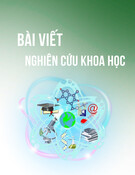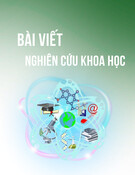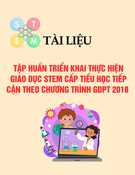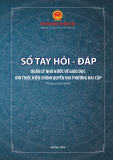
VĂN HÓA https://jst-haui.vn
Tạp chí Khoa học và Công nghệ Trường Đại học Công nghiệp Hà Nội Tập 61 - Số 2 (02/2025)
34
NGÔN NG
Ữ
P
-
ISSN 1859
-
3585
E
-
ISSN 2615
-
961
9
INFLUENCES OF TEACHER IMMEDIACY ON ADULT
LANGUAGE LEARNERS' THREE DOMAINS OF LEARNING:
A LITERATURE REVIEW
ẢNH HƯỞNG CỦA TÍNH TRỰC TIẾP CỦA GIÁO VIÊN LÊN NGƯỜI HỌC NGOẠI NGỮ
Ở ĐỘ TUỔI TRƯỞNG THÀNH THEO BA MIỀN HỌC TẬP: TỔNG QUAN LÝ THUYẾT
Pham Hoang Dan1, Pham Hoang Diep2
DOI: http://doi.org/10.57001/huih5804.2025.034
ABSTRACT
Over the past few decades, educational researchers and scholars have
extensively studied teacher immediacy and its multifaceted effects on
learners
across various academic disciplines. While numerous studies have demonstrated
the positive correlation between teacher immediacy and student outcomes in
traditional classroom settings, there remains a need for a comprehensive
understanding of how
these interpersonal behaviors specifically impact adult
language learners. The investigation examines this relationship through the lens of
three fundamental learning domains: affective, cognitive, and behavioral learning.
This paper seeks to contribute to
the theoretical framework of teacher immediacy
by drawing its connections with adult language education across existing research.
Keywords:
Teacher immediacy; adult language learners; affective
learning; cognitive learning; behavioral learning.
TÓM TẮT
Trong vài thập kỷ qua, các học giả đã nghiên cứu sâu rộng về tính trực tiế
p
của giáo viên (teacher immediacy) và những tác động đa chiều của nó đối vớ
i
người học thuộc nhiều lĩnh vực khác nhau. Tuy nhiều nghiên cứu đã chỉ ra mố
i
tương quan tích cực giữa tính trực tiếp của giáo viên và kết quả học tập củ
a
học sinh, chúng ta vẫn cần hiểu một cách toàn diện về những tác độ
ng mà tính
trực tiếp của giáo viên mang đến cho người học ngoại ngữ ở độ tuổi trưở
ng
thành. Bài nghiên cứu sẽ phân tích tương quan này từ ba khía cạnh: miền họ
c
tập cảm xúc, miền học tập nhận thức và miền học tập hành vi, thông qua việ
c
liên hệ các nghiên cứu về tính trực tiếp của giáo viên với lĩnh vực giáo dụ
c ngôn
ngữ cho người trưởng thành.
Từ khóa: Tính trực tiếp của giáo viên, người học tuổi trưởng thành, miề
n
cảm xúc, miền nhận thức, miền vận động.
1School of Languages and Tourism, Hanoi University of Industry, Vietnam
2Hanoi Metropolitan University, Vietnam
*Email: danph@haui.edu.vn
Received: 25/9/2024
Revised: 15/11/2024
Accepted: 27/02/2025
1. INTRODUCTION
The concept of “immediacy” was proposed by Albert
Mehrabian, who defines it as communication behaviors
that enhance closeness, both physical and psychological,
among people [1]. Those behaviors vary from verbal (e.g.
humor, inclusive personal pronoun, first-name basis) to
non-verbal (e.g. eye contact, facial expression, body
language) [2] and are thought to increase the effectiveness
in communication as “people approach what they like and
avoid what they do not” [3]. Later on, the term “teacher
immediacy” emerges when instructors of various contexts
are observed to have applied those tactics in the classroom
to create a supportive learning environment.
Positioned as a “positive influence” [2] which is helpful
to students in general, teacher immediacy is particularly
relevant to language teaching and learning as both
involve communication. A sense of closeness helps
learners and teachers interact more, while language
acquisition, itself, relies on interaction of any and many
forms [4]. Besides, research proves that teachers’
behaviors and personalities can affect “the attitudes and
motivation of students” (Gardner & Lambert, as cited in
[5]). Consequently, strategies to enhance teacher-student
rapport might also support students’ learning journey.
Adult learners are defined as post-puberty individuals,
or those who start learning a new language after,
normally, the age of 18. They can be college students or
office workers, and even the elderly. Unlike younger
groups who are often in need of much guidance, adults
are experienced, independent, and goal-oriented [6].
Therefore, a friendly and caring instructor might be less
likely to impress them or affect their learning process.

P-ISSN 1859-3585 E-ISSN 2615-9619 https://jst-haui.vn LANGUAGE - CULTURE
Vol. 61 - No. 2 (Feb 2025) HaUI Journal of Science and Technology
35
This intrigues me as to how, specifically, teacher
immediacy influences adult language learners because
this group of learners has its distinct characteristics as
mentioned above. While much research has been
conducted on immediacy, they do not purposefully
target the older population nor emphasize how those
teaching strategies support or disrupt adults’ language
learning. For this reason, this paper hopes to provide a
comprehensive picture of teacher immediacy’s influence
on adults’ language learning by reviewing prior literature,
and from there, highlighting main findings and research
gaps that would inform later research.
2. TEACHER IMMEDIACY ON ADULT LANGUAGE
LEARNERS
Learners are believed to learn with three major
domains regardless of the course subject. The first one,
the cognitive domain, relates to the mechanism of
information recall and acquisition [7]. The behavioral
domain, also called psychomotor, refers to actions one
performs such as behavior changes or vocational skills [8].
The last one and the most widely researched in relation
with teacher immediacy is the affective domain. In this
domain, scholars examine the psychological
development of learners reflected through their “beliefs,
attitudes, impressions, desires, feelings, values,
preferences, and interests” (Friedman; Friedman &
Neuman; Picard, et al., as cited in [9]). However, it is
notable that the aforementioned realms are
interdependent: changes in one’s emotion would
inevitably affect one’s ability to retain knowledge or
practice physical skills and vice versa. Meanwhile, most
existing teacher immediacy papers solely dwell on a
selected aspect, be it affective or cognitive (and scant
attention on psychomotor) [10].
Therefore, this paper will synthesize and discuss the
possible influences of teacher immediacy on adult L2
learners from all three angles: affective, cognitive, and
behavioral learning. To collect relevant studies, two main
databases (Google Scholar and Scopus) are used, using
four keywords which are: “teacher immediacy”,
“cognitive learning”, “affective learning”, and
“behavioral” (the last keyword is purposefully cut short to
extend the searchability). After initial collection, further
filters are added to focus on language learning and
teaching, as well as limiting the targeted population to
college students, working adults, and senior people. The
paper’s authors then proceed to synthesize and analyze
collected studies to draw out a common consensus as
well as disparities regarding teacher immediacy and adult
learners’ language learning.
2.1. Teacher immediacy on adult L2 learners’ affective
learning
Interaction between teachers and students is
characterized by both spoken and unspoken
components, by either instructional conversations or
feelings of like and dislike, of dominance and
disobedience [3]. In another sense, a teacher-student
relationship cannot be free of affect, disregarding gender,
occupation, or age. By investigating numerous studies,
Witt and Wheeless affirm that the influences of teacher
immediacy “are invariably positive” on students’ affective
learning [11]. Considering adult learners, high immediacy
from teachers is shown to improve various affective
factors that are supportive to language learning and
mitigate those that hinder the process.
Several examinations on teacher and student
communication confirm a strong correlation between an
instructor’s verbal and/or non-verbal behaviors, and adult
students’ motivation. Frymier conducting a study on 178
college students finds that teacher immediacy positively
relates to student’s intrinsic motivation. Notably, her
revelation is still applicable for adults who are already
highly determined to learn from the beginning [2]. Various
other attempts at college students and working adults of
different demography also support this conclusion [12, 13,
14, 15], confirming that when instructors apply affinity-
seeking strategies, learners become more interested in the
subject matters and more invested in learning itself. This
rings true for an e-learning setting as well [16, 17].
Furthermore, a systematic review of verbal and non-verbal
teacher immediacy and student motivation by Liu
reemphasizes this tie, as well as pointing toward moderate
correlations with higher student achievements [18]. All in
all, findings consistently indicate the significance of
teacher immediacy to learners and their learning; for
motivation is, oftentimes, the most influential variable
ensuring an outcome of high proficiency.
Besides boosting students’ motivation, signs of
closeness would also affect their perception toward the
instructor. Rocca and McCroskey look into the impact of
teacher immediacy on students’ opinions and conclude
that: high teacher immediacy directly generates a
homophily between the two, making students feel more
connected to their instructor [19]. As adults are
independent, they do not need a coaxing figure like
children do, but rather a person to communicate with on
equal footing. As highlighted in prior studies, such a

VĂN HÓA https://jst-haui.vn
Tạp chí Khoa học và Công nghệ Trường Đại học Công nghiệp Hà Nội Tập 61 - Số 2 (02/2025)
36
NGÔN NG
Ữ
P
-
ISSN 1859
-
3585
E
-
ISSN 2615
-
961
9
sense of similarity might lead to: either a more positive
evaluation of the teacher’s assertiveness and
responsiveness [20], on his/her competence and
trustworthiness [21], or higher satisfaction with the
instructor and the course [22].
Furthermore, studies of teacher immediacy have
attended to one aspect of affective learning that is
singularly relevant to language learners: willingness to
communicate. Needless to say, communication and its
practice is the pillar of language acquisition, and a learner
would achieve great proficiency by vocalizing readily and
frequently in the target language [23]. Possessing a zeal
for interaction is essential for language learners, and the
ability to encourage such in a student is equally
important for language teachers. Meanwhile, both verbal
and non-verbal teacher immediacy have proved to be
positively correlated to a student’s willingness to talk in
class [24, 25, 26]. When the lecturer is immediate,
students are more inclined to speak up, to ask questions
and clarifications about either the lesson or other areas in
respectful manners [27]. This resonates with a much older
demographic, as revealed by Borkowska in a research
study on 55 years of age or older language learners.
Notably, certain teacher immediacy tactics (patience,
professional commitment, empathy) that create a
welcoming environment would truly help senior learners
overcome their fear of speaking up [28].
This reduction of fear could be explained by how
immediacy is associated with lessening foreign language
anxiety. A study on English-majored first year students by
Ballester shows a causal relationship between low
lecturer immediacy and high L2 anxiety in students [29].
Titsworth and colleagues (as cited in Manarte, Lopes, &
Pereira) similarly assert that effective communication
between teacher-students constructs a friendly learning
environment, allowing students to show their authentic
feelings, hence a reduction in emotional tension (anxiety)
for not just each individual but the class as a whole [30].
Unfortunately, most of the studies are conducted on
undergraduate L2 learners within a classroom context so
there is little data about the working adult group who
would operate in a different, less controlled environment.
2.2. Teacher immediacy on adult L2 learners’
cognitive learning
Unlike the consistent results from teacher immediacy
and affective learning research, opinions around the
effect of immediacy on adults’ cognitive learning are
largely divided.
In some studies, a positive correlation is found
between non-verbal immediacy and cognitive learning,
as college students concede they can recall knowledge
better in classes where lecturers do apply immediate
strategies [31, 32]. Similarly, Andersen and Andersen have
concluded that: numerous non-verbal behaviors (eye
contact, gestures, vocal modulation, proximity, facial
expressions, and touch) positively relate to “various
measures of cognitive gain” (as cited in [10]). Meanwhile,
Gholamrezaee and Ghanizadeh (find both verbal and
non-verbal immediacy positively impact Iranian college
students’ cognitive learning, though only on a moderate
scale [32] - nodding to Witt, Wheeless and Allen’s meta-
analytical review [33].
Additionally, cognitive learning is believed to occur
when a student’s affective domain is influenced by
immediacy. Manarte, Lopes, and Pereira cite recent
researchers of the opinion that psychological factors are
so vital to learning that enhancing learners’ motivation is
already “a catalyst of cognitive learning” [30]. Since
teacher immediacy is significantly impactful to affective
learning, it seems logical that an instructor’s affinity-
seeking techniques might help create suitable conditions
to trigger cognitive learning in adult language learners.
For example, studying new language items from an
immediate teacher would simultaneously fuel students’
determination to learn the language and capture their
attention to the lesson, consequently enforcing the
understanding and memorization of said information.
This indirect relation is advanced by several scholars such
as Comstock, Rowell, and Bowers or Kelley and Gorham in
terms of attention arousal to cognition; Rodriguez, Plax,
and Kearney in terms of non-verbal immediacy to
cognitive learning with affective learning as the central
causal mediator (as cited in [33]).
Still, others remain skeptical. The main concern would
be the difficulty in analyzing one’s cognition. Most
previous research has assumed that as full-pledged
adults, learners can accurately report on their cognitive
workings [10], but the actual functioning of the human
brain is far more complicated than mere reflections and
perspectives. Even the aforementioned empirical studies
on non-verbal immediacy do not resonate with intuitive
reasoning. Cognitive activation is often measured by
recall, synthesis, and information application on verbal
cues. Therefore, despite acknowledging it as a means of
communication, researchers struggle to explain how
non-verbal behaviors link with cognitive learning,

P-ISSN 1859-3585 E-ISSN 2615-9619 https://jst-haui.vn LANGUAGE - CULTURE
Vol. 61 - No. 2 (Feb 2025) HaUI Journal of Science and Technology
37
especially when cognitive development is largely
assessed via test grade, as asserted by Richmond,
Gorham, and McCroskey [10]. Later, King and Witt argue
for the use of confidence testing in assessing cognitive
learning, which might serve as a more valid tool for
linking teacher immediacy, affective learning, and
cognitive gain [34].
2.3. Teacher immediacy on adult L2 learners’
behavioral learning
Behavioral learning or psychomotor learning refers to
acquiring skills with physical movement and mental
component. Akin to the other two domains, there is
substantial evidence for linearity between teacher’s
immediacy and students’ intentions to partake in
activities [13, 10, 31, 35].
Nevertheless, intents do not always transpire into real
action, and up to now, very little research has fully
confirmed whether teacher immediacy can prompt
action in students. Dewaele and Li come close by looking
at 2000 Chinese university students’ socio-behavioral
learning engagement in relation with teacher
enthusiasm [36]. While teacher enthusiasm can be
interpreted as a sign of immediacy, the actual result only
shows small correlations between the two. Therefore, it
could be said that no conclusive link has been found
between immediacy and actual behavioral learning as of
date. Even less relation has been established between
teacher immediacy and adult language students’
behavioral learning. There definitely lies a gap in research
that requires more attention, although existing hurdles
are not easy to cross. The main attributors to this scarcity
can be methodology challenges or measurement
complexity.
3. CONCLUSION
Existing research provides information about teacher
immediacy and adult language learners. Out of the three
dimensions of adults’ learning, teacher immediacy leaves
the most significant mark on the affective learning.
Apparently, the observed relationship is linear when the
higher the immediacy, the higher the affect. Writings on
cognition development provide evidence that teacher
immediacy might influence in correlation rather than in
direct forces, though there are rooms for further
discussion. Meanwhile, very little has been concluded on
immediacy and adults’ behavioral learning, thus, a need
for more attention to this aspect.
This paper hopes to deliver a more structured
understanding on possible impacts that teacher
immediacy might leave on adult L2 learners, thus
highlighting potential research areas of the same theme.
First of all, seeing how most existing studies focus on
college students, it would be enlightening if more
attention would be directed toward the working-age and
senior L2 learners. Besides, implementation of a more
credible assessment tool for cognitive gain would also be
helpful in establishing the true connection between
teacher immediacy and cognitive learning. Finally, seeing
as how recent studies have started to find certain (though
inconclusive) correlations between teacher immediacy
and behavioral language learning, more research could
be done to broaden the understanding of these two
spheres.
REFERENCES
[1]. Mehrabian A., “Some referents and measures of nonverbal behavior,”
Behavioral Research Methods and Instrumentation, 1, 213-217, 1969.
[2]. Frymier A. N., “The impact of teacher immediacy on students’
motivation: Is it the same for all students?,” Communication Quarterly, 41,
454-464, 1993.
[3]. Mehrabian A., Silent messages: Implicit communication or emotions
and attitudes, 2nd ed. Belmont, CA: Wadsworth, 1981.
[4]. Johnson K., Johnson, H., eds., "Interaction hypothesis”, Encyclopedic
Dictionary of Applied Linguistics: A Handbook for Language Teaching. Oxford:
Blackwell Publishers, 1999.
[5]. Liando N., “Students’ vs. teachers’ perspectives on best teacher
characteristics in EFL classrooms,” TEFLIN Journal: A publication on the teaching
and learning of English, 21(2), 118-136, 2010.
[6]. Smith A. F. V., Strong G., Adult language learners: Context and
innovation. Alexandria, VA: TESOL Publications, 2009.
[7]. Bloom B. S., Ed., Taxonomy of educational objectives. Handbook I: The
cognitive domain. New York: McKay, 1956.
[8]. Simpson, E. J., The classification of educational objectives in the
psychomotor domain. Washington, DC: Gryphon House, 1972.
[9]. Allen K. N., Friedman B. D., “Affective learning: A taxonomy for
teaching social work values,” Journal of Social Work Values & Ethics, 7, 2010.
http://www.socialworker.com/jswve
[10]. Richmond V. P., Gorham J. S., McCroskey J. C., “The relationship
between selected immediacy behaviors and cognitive learning,” Annals of the
International Communication Association, 10(1), 574-590, 1987.
[11]. Witt P. L., Wheeless L. R., “An experimental study of teachers’ verbal
and nonverbal immediacy and students’ affective and cognitive learning,”
Communication Education, 50, 327-342, 2001.

VĂN HÓA https://jst-haui.vn
Tạp chí Khoa học và Công nghệ Trường Đại học Công nghiệp Hà Nội Tập 61 - Số 2 (02/2025)
38
NGÔN NG
Ữ
P
-
ISSN 1859
-
3585
E
-
ISSN 2615
-
961
9
[12]. Christophel D. M., “The relationships among teacher immediacy
behaviours, student motivation and learning,” Communication Education, 39,
323-340, 1990.
[13]. Christophel D. M., Gorham J. S., “A test- retest analysis of student
motivation, teacher immediacy and perceived sources of motivation and
demotivation in college classes,” Communication Education, 44, 292-306, 1995.
[14]. Frymier, A. N., “A model of immediacy in the classroom”,
Communication Quarterly, 42, 133-144, 1994.
[15]. Furlich S., “Understanding instructor nonverbal immediacy, verbal
immediacy, and student motivation at a small liberal arts university,” Journal
of the Scholarship of Teaching and Learning, 16(3), 11-22, 2016.
[16]. Ge Z. G., Zhang A. Y., Li Y. F., Su J., “Exploring the impact of teachers’
verbal immediacy as an emotion mediating factor on adult e-learners’
language learning,” Journal of Educational Technology & Society, 22(4), 77-89,
2019.
[17]. Baker J., “An investigation of relationships among instructor
immediacy and affective and cognitive learning in the online classroom,” The
Internet and Higher Education, 7, 1-13, 2004.
https://doi.org/10.1016/J.IHEDUC.2003.11.006.
[18]. Liu W., “Does teacher immediacy affect students? A systematic
review of the association between teacher verbal and non-verbal immediacy
and student motivation,” Frontiers in Psychology, 12, 1-13, 2021. Doi:
10.3389/fpsyg.2021.713978
[19]. Rocca K. A., McCroskey J. C., “The interrelationship of student ratings
of instructors’ immediacy, verbal aggressiveness, homophily, and
interpersonal attraction,” Communication Education, 48, 308-316, 1999.
[20]. Thomas C. E., Richmond V. P., McCroskey J. C., “The association
between immediacy and socio-communicative style,” Communication
Research Reports, 11, 107-115, 1994.
[21]. Teven J. J., Hanson T. L., “The impact of teacher immediacy and
perceived caring on teacher competence and trustworthiness,”
Communication Quarterly, 52(1), 39-53, 2004.
[22]. Moore A., Masterson J. T., Christophel D. M., Shea K. A., “College
teacher immediacy and student ratings of instruction,” Communication
Education, 45, 29-39, 1996.
[23]. Matsuoka R., Evans D. R., “Willingness to communicate in the second
language,” Nurse Studies, 4(1), 3-12, 2005.
[24]. Gol M., Zand-Moghadam A., Karrabi M., “The construct of
willingness to communicate and its relationship with EFL learners' perceived
verbal and nonverbal teacher immediacy,” Issues in Language Teaching 3(1),
135-160, 2024.
[25]. Hsu L. I., Watson T., Lin C. H., Ho T. C., “Explorations in teachers’
nonverbal immediacy behaviors and students’ willingness to talk in English,”
English Teaching & Learning, 31(3), 1-27, 2007.
[26]. Menzel K. E., Carrell L. J., “The impact of gender and immediacy on
willingness to talk and perceived learning,” Communication Education, 48(1),
31-40, 1999.
[27]. Book C. L., Putnam J. G., “Organization and management of a
classroom as a learning community culture,” in Richmond V. P. & McCroskey J.
C., Eds., Power in the classroom: Communication, control, and concern, 19–34,
1992. Hillsdale: Erlbaum.
[28]. Borkowska A., “The relationship among age-advanced learners’ in-
class willingness to communicate in English, intrinsic motivation, classroom
environment and teacher immediacy - A pilot study,” Theory and Practice of
Second Language Acquisition, 8(2), 1-25, 2022. Doi: 10.31261/TAPSLA.8989
[29]. Ballester E. P., “Verbal and nonverbal teacher immediacy and
foreign language anxiety in an EFL university course,” Porta Linguarum, 23, 9-
24, 2013.
[30]. Manarte J., Lopes A., Pereira F., “Contributions to the empirical study
of immediacy in the pedagogical relationship through self-narratives,” Journal
of Pedagogy, 5(2), 209-225, 2014.
[31]. Richmond V. P., McCroskey J. C., Kearney P., Plax T. G., “Power in the
classroom VII: Linking behavior alteration techniques to cognitive learning,”
Communication Education, 36, 1-12, 1987.
[32]. Chesebro J. L., McCroskey J. C., “The relationship between students'
reports of learning and their actual recall of lecture material: A validity test,”
Article in Communication Education, 49(3), 297-301, 2000.
[32]. Gholamrezaee S., Ghanizadeh A., “EFL teachers’ verbal and
nonverbal immediacy: A study of its impact on students’ emotional states,
cognitive learning, and burnout,” Psychological Studies, 63(4), 398-409, 2018.
Doi: 10.1007/s12646-018-0467-5
[33]. Witt P. L., Wheeless L. R., Allen M., “A meta-analytical review of the
relationship between teacher immediacy and student learning,”
Communication Monographs, 71(2), 184-207, 2004.
[34]. King P., Witt P., “Teacher immediacy, confidence testing, and the
measurement of cognitive learning,” Communication Education, 58, 110 - 123,
2009. Doi: 10.1080/03634520802511233
[35]. Sanders J. A., Wiseman R. L., “The effects of verbal and nonverbal
teacher immediacy on perceived cognitive, affective, and behavioral learning
in the multicultural classroom,” Communication Education, 39(4), 341-353,
1990.
[36]. Dewaele J., Li C., “Teacher enthusiasm and students’ social-
behavioral learning engagement: The mediating role of student enjoyment
and boredom in Chinese EFL classes,” Language Teaching Research, 25, 922 -
945, 2021. Doi: 10.1177/13621688211014538
THÔNG TIN TÁC GIẢ
Phạm Hoàng Đan1, Phạm Hoàng Điệp2
1Trường Ngoại ngữ - Du lịch, Trường Đại học Công nghiệp Hà Nội
2Trường Đại học Thủ đô



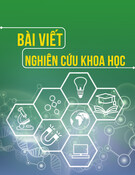


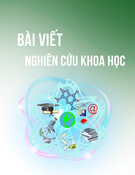


![Câu hỏi ôn tập môn Tâm lý học giáo dục [chuẩn nhất]](https://cdn.tailieu.vn/images/document/thumbnail/2025/20250710/kimphuong1001/135x160/59611752136982.jpg)
